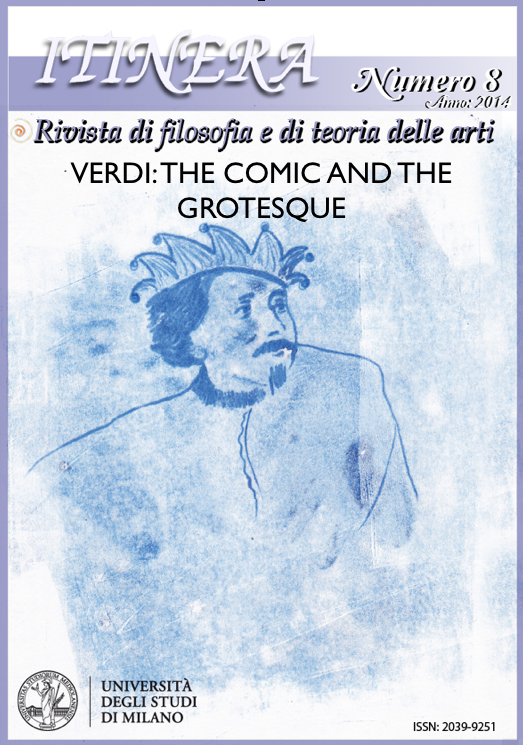Il belcanto di Oscar: trasformazioni grottesche del paggio operistico
DOI:
https://doi.org/10.13130/2039-9251/4597Abstract
The grotesque can then be seen as the aesthetic effect generated by the clash between different categories and genres of representation. The dramatic function of the page Oscar in Un ballo in maschera arises from the cross of two different triangles: the dramatic positions tieing him with Cherubino (Nozze di Figaro) and Smeton (Anna Bolena), and the vocal triangle binding him to Abigaille (Nabucco) and Gilda (Rigoletto). In this case, infact, Verdi declines, the version nor heroic nor pathetic but grotesque of belcanto. For his vocality, Oscar is in an eccentric position with respect to the line that binds the operatic pages such as Cherubino and Smeton. This line, however, constitutes the reference horizon on which he projects himself, according to well established Nineteenth-Century expectations of the spectators.
Riferimenti bibliografici
BASEVI, Abramo, Studio sulle opere di Giuseppe Verdi, Tofani, Firenze 1859.
BENTLEY, Eric, The Life of Drama, Atheneum, New York 1979.
BERLIOZ, Hector, I grotteschi della musica (1859), tr. it. di A. Taverna, Zecchini, Varese 2004.
BERTOLINI, Michele, “Economie del grottesco nell’opera letteraria di Balzac: Le cousin Pons”, Itinera, VI, 2013, pp. 64-81.
BROOKS, Peter, L’immaginazione melodrammatica (1976), tr. it. di D. Fink, Pratiche, Parma 1985.
BUDDEN, Julian, Le opere di Verdi, vol. II: Dal Trovatore alla Forza del destino (1978), tr. it di J. Douthwaite, EDT, Torino 1986.
CELLETTI, Rodolfo, “Caratteri della vocalità di Verdi”, in M. Medici, M. Pavarani (a cura di), Il teatro e la musica di Giuseppe Verdi. Atti del III congresso internazionale di studi verdiani Milano 12–17 giugno 1972, Istituto di studi verdiani, Parma 1974, pp. 81-88.
—, Storia del belcanto, Discanto, Firenze 1983.
CONATI, Marcello, La bottega della musica, Il Saggiatore, Milano 1983.
CRUTCHFIELD, Will, “The Dangers of Singing Abigaille in Nabucco”, Opera News, LXV/9, 2001, pp. 36-41.
DAHLHAUS, Carl, Drammaturgia dell’opera italiana, a cura di L. Bianconi, EDT, Torino 2005.
GEOFFRAY, Edwards, EDWARDS, Ryan, Verdi and Puccini Heroines. Dramatic Characterization in Greatsoprano Roles, Scarecrow Press, Lanham-London 2001.
GIGER, Andreas, Verdi and the French Aesthetic. Verse, Stanza, and Melody in Nineteenth-Century Opera, Cambridge University Press, Cambridge 2008.
HADLOCK, Heather, “The Career of Cherubino, or the Trouser Role Grows up”, in M.A. Smart (a cura di), Sirens Songs. Representations of Gender and Sexuality in Opera, Princeton University Press, Princeton 2000, pp. 67-92.
KOESTLER, Arthur, L’atto della creazione (1969), tr. it. di G.M. Nivi, Astrolabio-Ubaldini, Roma 1975.
MARICA, Marco, “Libretto e guida all’opera”, in M. Girardi (a cura di), Nabucco, Teatro La Fenice, Venezia 2004, pp. 9-58.
—, “Libretto e guida all’opera”, in M. Girardi (a cura di), Luisa Miller, Teatro La Fenice, Venezia 2005, pp. 55-112.
MAZZOCUT-MIS, Maddalena, Mostro. L’anomalia e il deforme nella natura e nell’arte, Guerini, Milano 1992.
PENDLE, Karin S., Eugène Scribe and French Opera of Nineteenth Century, UMI, Ann Arbor 1979.
RICCIARDI Simonetta (a cura di), Carteggio Verdi-Somma, Istituto Nazionale di Studi Verdiani, Parma 2003.
RIGGS, Geoffrey S., The Assoluta Voice in Opera 1797–1847, McFarlan, Jefferson 2003.
ROSEN, David, “How Verdi’s Serious Operas End”, in L. Bianconi, F.A. Gallo, A. Pompilio, D. Restani (a cura di), Trasmissione e recezione delle forme di cultura musicale. Atti del XIV congresso della Società internazionale di Musicologia (Bologna, 27 agosto – 1 settembre 1987; Ferrara-Parma, 30 agosto 1987), EDT, Torino 1990, vol. III, pp. 443-450.
ROSENKRANZ, Karl, Estetica del brutto (1853), a cura di R. Bodei, Il Mulino, Bologna 1984.
ROSSELLI, John, Il cantante d’opera (1992), tr. it di P. Russo, Il Mulino, Bologna 1993.
RUTHERFORD, Susan, The Prima Donna and Opera, 1815–1930, Cambridge University Press, Cambridge 2006.
SCARAMUZZA, Gabriele, “Il brutto e il grottesco tra Macbeth e Luisa Miller”, Itinera, VI, 2013, pp. 36-50.
SCHNEIDER, Magnus, ELVER, Anthon Nicolai, “Gilda’s Voices: On Potential Meanings, Intertextuality and Vocal Performance in Verdi’s Rigoletto”, Nordic Theatre Studies, XVII, 2005, pp. 24-37.
STAFFIERI, Gloria, “Eugène Scribe ‘sceneggiatore’ del grand opéra”, Il Saggiatore musicale, XVI, 2007, pp. 5-54.
VAN, Gilles de, Verdi. Un teatro in musica (1992), tr. it. di R. de Letteriis, La Nuova Italia, Firenze 1994.
—, “‘Un bal masqué’ d’Auber à Verdi: une perspective inversés”, in H. Lacombe (a cura di), L’opéra en France et en Italie (1791–1925). Une scène privilégiée d’échanges littéraire et musicaux. Actes du colloque franco-italien tenu à l’Académie musicale de Villecroze (16–18 octobre 1997), Société Française de Musicologie, Paris 2000, pp. 223–234; tr. it. “Dal ‘Ballo in maschera’ di Auber a quello di Verdi: una prospettiva invertita”, in I quaderni del Festival Verdi, n° 5: Un Ballo in maschera, Teatro Regio, Parma 2011, pp. 67–75.
—, “Le Grand opéra entre tragédie lyrique et drame romantique”, Il Saggiatore musicale, III, 1996, pp. 325-360.
Dowloads
Fascicolo
Sezione
Licenza
Gli autori che pubblicano su questa rivista accettano le seguenti condizioni:
1. Gli autori mantengono i diritti sulla loro opera e cedono alla rivista il diritto di prima pubblicazione dell'opera, contemporaneamente licenziata sotto una Licenza Creative Commons - Attribuzione - Condividi allo stesso modo 4.0 internazionale che permette ad altri di condividere l'opera indicando la paternità intellettuale e la prima pubblicazione su questa rivista.
2. Gli autori possono aderire ad altri accordi di licenza non esclusiva per la distribuzione della versione dell'opera pubblicata (es. depositarla in un archivio istituzionale o pubblicarla in una monografia), a patto di indicare che la prima pubblicazione è avvenuta su questa rivista.
3. Gli autori possono diffondere la loro opera online (es. in repository istituzionali o nel loro sito web) prima e durante il processo di submission, poiché può portare a scambi produttivi e aumentare le citazioni dell'opera pubblicata (Vedi The Effect of Open Access).





